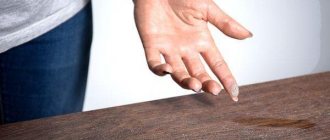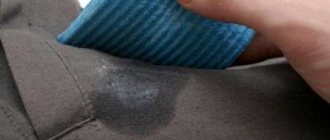How do professionals deal with dust?
Professional builders have in their arsenal a special tool to combat the resulting flour: an attachment on a drill or drill, to which a hose from a vacuum cleaner is connected. This addition to the hammer drill helps collect garbage very cleanly, but it has a number of disadvantages:
- You have to spend money to purchase a nozzle. Such expenses are appropriate if you have to drill constantly. But if you occasionally have to drill one or two holes in the ceiling or wall, it is irrational to buy a special nozzle.
- As a rule, using the nozzle requires the help of a partner who will hold the vacuum cleaner. In everyday life, improvised do-it-yourself devices are used to solve the same problems.
We drill dust-free holes in the ceiling and walls.
Before this topic “Drilling (drilling) without dust,” I talked about how to cut without dust using a grinder. This process was described in the article Installing a dust-free groove. Well, now I was asked to tell you how to do this only when working with a drill or hammer drill. So, go ahead for new knowledge and solutions, because methods will be presented that will allow you to drill and drill in such a way that dust from under the drill does not fly around the room and, as a result, you do not have to spend a long time and tediously clean up! We will tell you how to make sure that when drilling the ceiling (with a drill, a crown), concrete or plaster chips do not fall on your face!! Go
.
All builders face a problem when drilling, drilling holes in the ceiling and walls. When a hammer drill or drill sprinkles small or even large fractions of drilling waste, simply dust particles, into your eyes, onto the floor and pieces of furniture, as well as your hands.
So, I propose to deal with this small nuisance using the old-fashioned method, by putting a regular plastic or cardboard cup on a drill, drill, or cardboard!!
Just insert a drill through the center of the cup
, the cup faces completely towards the drilling and at the moment of drilling, crumbling dust, particles of the concrete fraction, will fall into the plastic cup, which will greatly simplify further cleaning of the apartment and protect your eyes from dust. Although you should have glasses for this matter. Well, if anything, it won’t get into your mouth!! :))
This method of drilling, drilling without dust, is suitable for drills or drills no less than ten centimeters long, including the heel of the drill! Otherwise, the selected container will need to be shortened in length.
You can also drill a wall without dust.
, only in this case a vacuum cleaner or a bag glued to the wall in the place where you are going to make a hole will help us.
At the moment when you are drilling a wall, your partner or yourself will have to place a vacuum cleaner under the hole. The vacuum cleaner will suck up all the dust coming out from under the drill and will not allow it to scatter or crumble. So we figured out how to drill a hole in the ceiling and wall without dust using a drill and a hammer drill.
Then there are a few more instructions and, as always, interesting, in which I cut six short videos that show methods of drilling holes without dust, where dust is caught using special purchased devices and using homemade things.
Without resorting to the use of special drills with nozzles that draw in air, Americans do an excellent job.
When drilling a wall or ceiling, they do not use a plastic cup or a vacuum cleaner like we do, but a specially designed bag, into which all the fine particles fall during drilling.
This container is put on the drill and when the drill rotates, by analogy, production occurs along the grooves into the package. This is clearly visible in the photo below.
What mistakes did I make and what mistakes should you not make?
The wall I was drilling was quite thick. About thirty centimeters. She stood as a barrier between the kitchen and the loggia. Why drill? I'm not a big fan of boxes and I think that they look extremely unesthetically pleasing, so it's better to make one small hole in the wall to thread the cable through, rather than spoil the appearance with a bunch of plastic.
Armed with a hammer drill, I got to work. The first mistake I made was putting too much pressure on the wall at the beginning of the drilling process. You see, if the drill bit is quite long, putting too much pressure on it will create unnecessary deformation, which will either break the bit itself or cause the chuck to become loose.
In my case it was the second option, and the cartridge was practically torn from the base due to the vibrations created. Fortunately, I had a hammer drill at home, and I easily performed the same procedure without any problems.
I’ll explain why I didn’t immediately use a hammer drill, because that’s what it’s designed for. The answer is simple. I knew that the wall was made of brickwork, which means that it was an order of magnitude softer than concrete. Therefore, using an impact drill seemed optimal to me. There was no desire to take out a huge, in my opinion, hammer drill from the pantry, but the miser pays twice.
The second attempt to take the brick wall was successful. The next step was the holes in the concrete ceiling slab, which would later hold the profiles for. For this I used a drill much smaller. It was eight millimeters in diameter and about 9–10 centimeters in length.
Already with a hammer drill in my hands, I climbed onto the ladder, raised my head up, chose a place and began to drill. The stove did not give in to me. I decided that the effort was not enough, and it would be quite reasonable to push even harder. Having pressed, all I managed to see was the moment the drill broke into two halves, lasting one moment, and how the upper (broken off) part fell right into my eye.
Without having time to react to the attack of the drill, I just stood there, petrified. The fragment hit the safety glasses, was deflected and fell to the ground. At that moment, I realized that it was not in vain that I studied safety precautions so diligently and always follow them. Otherwise, I would have been left without an eye out of stupidity. The mistake this time was that next to the Pobedit drill I needed for working with concrete walls and slabs there was another, ordinary one, which in appearance was barely different from what was needed.
A mistake was made, but not in vain. You see, an ordinary drill, although barely, drills through concrete. It made a small hole in the ceiling, allowing the drill not to slip on the surface. The main thing is not to overdo it when doing it.
So, the mistakes I made:
- pressed too hard on the drill when drilling a hole;
- made a mistake when choosing a drill;
- overestimated the talent of the impact drill.
Avoid these mistakes and using the instructions below, you will achieve the desired result without any problems.
I would also like to once again draw additional attention to safety precautions. Quite a few people neglect to even use safety glasses, ending up damaging their eyes and, at best, losing their vision. It wouldn't be difficult for anyone to put a little plastic on their face to stay intact.
Drilling with a hammer drill without dust or how to work with a hammer drill without dust
When drilling a hole in concrete or brick with a hammer drill, a lot of dust is generated. When construction processes are underway, this does not bother anyone. If you need to drill a hole in a residential, clean room, this becomes a problem. Dust, especially brick dust, will ruin wallpaper, upholstered furniture and other interior elements.
In this article we will discuss how to work with a hammer drill without dust. Or how to neutralize it during work.
Drilling holes with a hammer drill without dust.
Disadvantages when using a vacuum cleaner
Some people use a vacuum cleaner. This is a good option to avoid dust when drilling with a hammer drill, but not always acceptable. This device may not be at hand. It requires two people to operate it. One drills a hole with a hammer drill, the other holds the suction tube of the vacuum cleaner next to the working part of the drill. All dust is sucked into the vacuum cleaner. But you can’t handle this situation alone. It is inconvenient for one person to monitor two operating devices at the same time, holding their parts in the right places.
How to drill a wall without dust
To drill a wall with a hammer drill without dust, you will need two things: tape and a plastic bag, which are used for packaging.
It is preferable to use masking tape. Let's mark future holes on the wall in the right places. Place an open plastic bag under the mark on the wall with tape. It should be held in such a way that all the drilling dust falls inside it. You can drill carefully, the main thing is not to overdrive. Then the waste is poured into a bag.
As soon as you increase the speed of the hammer drill, some of the rot will be blown around by the air flow from the engine fan. If you hit it carefully, at low speeds, the process will go just fine. You will collect all the dust in a plastic bag. It can be used repeatedly.
An important point: the tape must be glued to the wall very tightly. Inadequate gluing will result in dust falling between the wall and the tape and staining the wallpaper.
How to drill a ceiling with a hammer drill without dust
Here the situation is more complicated. You can apply the same construction as described in the previous paragraph. But the effect will be worse. As an option, we use a disposable plate or a disposable plastic container, pierced in the middle with a drill. If you don’t increase the speed too much, then most of the debris when drilling the ceiling will end up in this additional element. During operation, this plastic part will need to be held with your hand to avoid its rotation.
Drilling with a hammer drill without dusting the ceiling.
The best option in this case would still be a vacuum cleaner.
In general, decide how to operate a hammer drill without dust in accordance with the situation.
buildip.ru
My readers' experience
Tip 1
Half-mask respirators are complete rubbish. Spraying water does not clear the air of fine—the most dangerous and most volatile dust. If you have a partner and the opportunity, to reduce the FORMATION of dust, try spraying the grinder disk on the place where it fits into the groove being cut. Since pneumoconiosis is incurable, use RPE that is more effective than half masks (in order of increasing effectiveness): full-face masks with P3 filters (BUT so that the size matches your face), and they also have forced supply of clean or filtered air under the mask (so that unfiltered air did not leak through the gaps between the mask and the face - the main problem of RPE). The second option is more expensive, to put it mildly. The compromise is to work intermittently, tightening the headband fastening straps (to press the full face mask tightly against the face). In industry they use ventilation, but this is unlikely to suit you. Although drilling in the ceiling with a vacuum cleaner in one hand and a drill in the other is quite possible.
Tip 2
It was an experience. The apartment is residential. Renovation only in the kitchen. I moved the sockets, chiseled the walls (concrete) with just the same diamond disc as you have in the video, concrete with stones. Goal: to protect the apartment from dust; it is clear that in the kitchen itself there is a column of dust.
Option 1. Hang 2 sheets of dense polyethylene on the door with a large overlap of the wings vertically, with the ability to connect them with Velcro or a zipper. This option was prompted by the mobile chemical laboratory system. Polyethylene - so that dust rolls down. Dense - to walk on, so as not to tear. Velcro - to protect the passage and the gap in the middle. Apply tape around the perimeter of the door jamb. We didn’t get around to Velcro (there was no one to sew), and since the polyethylene is dense, the gaps still remained. I declined this option.
Option-2: The idea is the same, but instead of polyethylene I used 2 wet sheets, the tape around the perimeter of the door fell off by itself, and was replaced by nails and buttons. The overlap on the walls along the perimeter is 20-30 cm, in the middle of the passage it is also about 30 cm. Before dusty work, I removed it, wet it generously, and as it dried, sprayed it with a flower spray bottle. At the bottom, along the width of the door, I laid a wooden beam, pressed the sheets, provided tension, and thereby plugged the bottom gap. The main thing is that there is no draft in the apartment; all windows must be closed. At the end of the work (when the dust is thick and you are there), breathing all this goodness is harmful. I tried to spray the air to knock down dust, but the effect is weak + dirt appears. Additionally, he opened the window in the kitchen, put a fan opposite it to blow it out and went through the “wet barrier” into another room, waiting for the dust to settle. Result: dust seeped from the kitchen into the corridor and settled on the floor at a distance of about 3 meters (this was helped by the natural convection of air in the apartment), but beyond that there was no obvious dust. Daily cleaning of the corridor in the evening saved me from the displeased glance of my wife. Of course, and without fail, any renovation requires cleaning the entire apartment; dust appears always and everywhere. I hope someone will find my experience useful.
So, today we learned what construction dust is, where it comes from, and in what cases it occurs most often. How to protect your respiratory organs from it, how to work, protecting your furniture and other valuable accessories from it in the house.
At the same time, you need to remember that in addition to personal protective equipment during repairs, you can use safe technologies, such as odorless interior paint, this will also help preserve your health.
How to drill without dust? Three effective ways. Why do you need to deal with dust?
Before we talk about control methods, we decided to clarify the motives for eliminating dust. They are quite obvious, so they won’t be a revelation to anyone. There are three prerequisites:
- Reason one is harmful to health. When particles of construction waste get into the respiratory tract and eyes, they not only cause discomfort, but also become a prerequisite for further health problems for the master;
- Reason two: harm to household and construction devices. It seems that a hammer drill or drill adapted for drilling is not afraid of construction dust, but this is not so. If particles of cement or brick flour get into the gears of the mechanism, they can damage the tool. The same applies to household devices, if you do not protect them from dirt, in other words, there is a huge possibility that dust will damage the internal mechanism of the equipment;
- Reason three is the formation of dirt. After drilling, wet cleaning and washing of the floors will be necessary. Mixing with water, the dust turns into dirt, which is very difficult to wash off the first or even the second time.
Drilling tool
If you're wondering what to use to drill into a brick wall, there are several options to consider to decide which one is right for you. The simplest method is mechanized, which involves the use of a hammer and a bolt. This work algorithm will not allow large-scale work to be completed, but if there is only one hole, this approach will be ideal.
A more technologically advanced method compared to manual drilling is the electromechanical method. Here you can’t do without a drill, or, at a minimum, or at a maximum, without a hammer drill. It is better if the drills and augers are new, then the work will go faster. But diamond drilling of brick walls is usually carried out by professionals. It usually does not produce dry dust, but the work area will still require cleaning. The thing is that diamond drilling is accompanied by cooling of the equipment with water. However, only specialists can cope with such a task.
Attention! If you plan to drill brick walls yourself using electric household tools, you need to not only mark the hole, but also core the future hole. This will prevent the drill from slipping
Homemade dust control devices
Improvised devices sometimes cannot boast as complete dust removal as professional vacuum cleaner attachments. But they are much cheaper and often do not require assistance during use.
Drill attachment from a bottle or cup
If you need to drill a hole in the ceiling, the crumbled concrete will mostly fall down. To collect dust, a combination of a drill or auger and a bottle with a cut off bottom will help. An ordinary plastic cup will do, but it will need to be cut so that the part of the drill that will go into the wall protrudes above the walls. As a result, the “flour” falling down will fall into the cup and will be easy to remove.
Moistened sponge
You can make a nozzle from a sponge:
- the center is measured on it;
- draw a circle with a diameter of about 5 mm in the center;
- cut the foam rubber in a circle with a stationery knife and remove it to a hard substrate;
- a hole is made in the substrate into which a drill is inserted;
- Before starting work, moisten the sponge with water.
Like the previous device, this option is more effective if you need to drill the ceiling rather than the wall.
Paper envelope
An envelope made of thick paper is attached to the wall under the place where the hole will be drilled with double-sided tape. You can make it yourself by bending the sheet in half and staple it along the edge. The garbage will fall down, collecting in the envelope. Instead of an envelope, you can glue a paper cup.
The main disadvantage of this method is that light dust blown to the sides is not collected.
We use a vacuum cleaner
You can use the vacuum cleaner even without a special attachment.
- The easiest option is to draw in air with the narrowest slot-shaped nozzle. It creates a very powerful stream that draws in flour particles well. The disadvantage of this method is that you need an assistant.
- The second option is to build a nozzle from a plank with a drilled hole and a collection from a cut bottle attached to it. Then the drill is inserted through the holes in the bottle and the board, and the vacuum cleaner is connected to the neck.
Drilling jig
Using such a device will not only reduce the amount of dust in the process, but will also help not to move while drilling and make a more accurate hole. It is necessary to make a plank from plywood or other suitable material and drill holes in the designated places. This plank is fixed to the wall using double-sided tape, glue or other fastening element. Another one is fixed to the bottom of the plank at an angle of 90 degrees, in the form of a kind of shelf. This way, the debris will settle on a horizontal bar to reduce the amount of waste on the floor and make cleaning easier afterwards.
Stationery sticker
The easiest way to reduce the appearance of dust on the floor is to place a stationery sticker under the drill on the floor or by securing it with an adhesive edge to the wall. After finishing work, you just need to roll it up and throw the sticker in the trash.
But there is one drawback: construction dust flies not only downwards, but also to the sides, so when using a sticker, prepare a vacuum cleaner and a wet rag to remove any remaining dirt scattered around the room.
Application of dust collector
You can make a dust collector yourself. You need to use a paper or plastic cup, make a hole in the bottom and put it on the drill. Dust and fine particles from the ceiling will fall into the glass.
You can make a paper funnel. It is fastened with tape, the sharp part of the cone is cut off and also attached to the drill using tape, above the drill mount. The disadvantage of these methods is that dust still blows around the apartment, albeit in much smaller quantities.
You can use half a children's rubber ball as a dust collector. The principle of fastening is the same as with a glass. You just need to be careful when working with such a dust collector so as not to inadvertently smear the rubber ball on the ceiling - it may leave a mark.
A vacuum cleaner will catch dust from drilling the ceiling well. There is a nuance here: in order to do quality work, you can’t do it alone. You definitely need an assistant who will hold the vacuum cleaner hose in close proximity to the drilling site.
Simple tricks
You can drill a hole in a wall made of concrete, brick or plaster or in a floor slab using a drill with a Pobedit drill bit or a hammer drill. To reduce the likelihood of fine particles spreading throughout the room, take the advice of professionals and find out how to drill a dust-free wall or ceiling:
- Use a vacuum cleaner when working. In this case, you will need an assistant. While one person drills the surface, the second holds the hose without a nozzle in close proximity to the drill. Using a vacuum cleaner it is possible to collect flying dust, but this option is only suitable for making shallow holes if you have a partner;
- Glue a paper envelope to collect dust. When drilling vertically, take a regular envelope (you can use it) or fold a sheet of A4 paper like a pocket, then attach the paper dust collector to the wall with masking tape;
- Place a plastic cup over the drill. The method is only suitable for making deep holes (from 5 to 12 cm) of large diameter in surfaces. Take a plastic or paper cup, make a hole in the bottom with a knife and put it on the drill. If necessary, cut the glass so that the heel of the drill remains inside. This technology is most often used to drill dust-free holes on the ceiling.
Safety precautions
Any construction or repair work is associated with certain risks, so it is important to know how to drill concrete without injury. A number of rules must be followed:
First you need to check that there are no pipes or electrical wiring in the drilling area. This can be done using a metal detector. If possible, turn off electricity in areas where repairs are being carried out. The drill is connected to a separate socket connected to the distribution panel. The metal detector may not recognize pipes or wiring under a decorative coating.
Drilling in such places must be done with caution so as not to unnecessarily damage the wall. If the house has hidden gas wiring, then the gas must be turned off during the work. It is strictly forbidden to drill seams in a block house. Communications are often laid in the channel between blocks in violation of building regulations. Be sure to check how the drill is secured in the chuck. During the drilling process, it is necessary to use protective equipment: glasses, gloves, special clothing
If you plan to work at height, wear a hat. Drilling produces a lot of dust. A protective mask or respirator must be used. When drilling through a wall, you must make sure that another person is not working on the opposite side. If the hole needs to be made at ceiling level, then the work is carried out not from a stepladder, but from scaffolding or a trestle. The stepladder is less stable. If there is no suitable support, then the stepladder is strengthened with stops. Do not turn on a tool that rests on the work surface. The pressure and speed increase smoothly.
- To ensure stability of the tool, it is held only by the handles. Holding a working drill by the chuck is strictly prohibited.
- In some regions there are legally set times during which noisy work cannot be carried out. This must be taken into account when drawing up an action plan.
To gain the skill, you need to drill a hole in concrete several times slowly and carefully. This will help you understand that if you follow the nuances and safety precautions, this work does not cause major problems and difficulties. Even beginners can do it on their own.
Types of drills for concrete - what are they?
How to groove a wall for wiring without a special wall chaser
How to properly paint a plastered wall with water-based paint
Sealing through holes and holes from hardware in a concrete wall
We drill dust-free holes in the ceiling and walls.
Before this topic “Drilling (drilling) without dust,” I told you how to cut without dust using a grinder. This process was described in the article - Installation of grooves without dust *. Well, today I was asked to tell you how to do this only when working with a drill or hammer drill. So, go ahead for new knowledge and solutions, as methods will be presented that will allow you to drill and drill so that dust from under the drill does not fly around the room and, as a result, you do not have to spend a long time and tediously cleaning! + We'll tell you how to make sure that when drilling the ceiling (with a drill, a crown), concrete or plaster chips don't fall on your face!! Go
All builders face a problem when drilling, drilling holes in the ceiling and walls. When a hammer drill or drill sprinkles small or even large fractions of drilling waste, simply dust particles, into your eyes, onto the floor and pieces of furniture, as well as your hands.
Bag, tube and rubber band
A cheap way to collect dust is to use a bag, a tube and an elastic band. The polyethylene is transparent, so everything will be perfectly visible. The anther is assembled from a tube with a hole, an elastic band and a bag. That's it, you can drill. You will definitely like the effect.
@In contact with
Important point! This option is not suitable for drilling the ceiling: it will be inconvenient.
You can choose any of the presented methods. They all really work.
Jig for drilling holes without dust
Due to the heterogeneity of the walls, especially those made of brick, the drill often “leads” away from the intended place and if there is more than one hole, then the suspended shelf does not hang horizontally or, even worse, it is impossible to hang it, since the installed dowels do not coincide with the mounting ones loops. You can use a jig in the form of a sheet of plywood with a pre-drilled hole, but when drilling due to vibration it can also move and again the result will not be what was expected. But there is a simple technology that allows you to drill two or more holes strictly in specified locations.
Precise hole drilling
It turns out that the problem can be solved very simply by gluing a sheet of any sandpaper with glue or double-sided tape to the entire area of the side of the conductor that is attached to the wall. At the same time, the adhesion of the jig to the wall surface increases many times over, and during drilling, the specified accuracy of positioning of the jig is ensured. The hole will appear exactly at the marking location.
Depending on the weight of the product and the density of the wall, you have to drill holes for dowels of different diameters, usually 6 or 8 mm. For the versatility of the jig, it is necessary to drill several holes of the desired diameters with an ordinary drill.
To top it off, attach a plate to the end of the base of the conductor at a right angle. Thanks to this modification, most of the drilling products will remain on this shelf, which will prevent contamination of the wallpaper and reduce the scattering of dust in all directions.
The proposed device is also indispensable when drilling holes for attaching skirting boards. Drill a hole in the jig at a given height from the shelf. When drilling, place the shelf on the floor and all the holes will be exactly at the required height from the floor, which will guarantee a tight fit of the plinth to the floor surface.
Sometimes you have to hang a product on the wall, for which you need to drill several holes in the wall and maintain the distance between them with greater accuracy. If the wall is brick and plastered, then it is impossible to perform accurate drilling without a jig.
To make a jig for precision drilling, a board, sheet of plywood or metal is suitable. After marking, the required number of holes is drilled in the sheet using an ordinary drill. Consider the case for fastening the product with two screws. One hole is drilled with a diameter equal to the diameter of the drill that will be used to drill the wall, the second with a diameter equal to the diameter of the self-tapping screw. After the jig is made, the first hole is drilled in the wall using the jig for the precision drilling described earlier, and a dowel is driven into the hole.
The jig is screwed to the wall using a self-tapping screw into the hammered dowel and leveled using a water level so that the drilled holes are on the same horizontal plane.
Thanks to the use of a simple jig, which can be made in a few minutes from any available material, the holes were created exactly at a given distance from each other.
Using the same technology, you can drill a whole series of holes at a greater distance from each other. In this case, first the outer holes are drilled using the technology described above, the jig is screwed with two outer self-tapping screws, and then all other holes are drilled.
The proposed options for conductors are convenient when renovating an apartment, when dirt is common everywhere. However, when the renovation is completed and cleaned up, drilling becomes stressful. You don’t want to stain your carpets and furniture with concrete or brick chips and dust.
Traditional methods
It often happens that a new hole needs to be made after the renovation is completed, at a time when the house is filled with furniture. The question arises, how to drill concrete without dust in this case? There are two most common methods that allow you to complete the task while keeping your work area clean.
Paper envelope
. This method is intended for drilling vertical surfaces. You will need a sheet of paper and tape. The paper needs to be folded in half and glued along the edges, thus creating an envelope. We glue this bag no lower than 20 mm from the drilling site. If you apply tape to wallpaper, you must remove excess glue. To do this, first stick the tape to your palm several times. To prevent dust from flying through the envelope, control the speed of the drill and do not pull the drill out too quickly.
Cup
The drill is used for drilling the ceiling. To make it you will need a plastic cup, scissors and tape. First, cut a hole in the bottom for the drill. Then we take a drill and use tape to attach the paper cup to the chuck.
Drilling concrete or brick is a simple matter. To do this, you only need a good impact drill and a drill bit with pobedit tips. Of course, you need to be mentally attuned to noise and dust. If you can put up with the noise, then dirty furniture, household appliances and carpets will not make anyone happy. There are two methods in the fight against dust: folk and progressive. Let's first look at the traditional method, which, frankly, only works when drilling holes in the ceiling. How to drill concrete without dust? An ordinary paper funnel attached to a drill helps to combat it.
Where does dust come from?
As a rule, hard materials are drilled with a hammer drill or impact drill. A drill, drill bit or other tool destroys the material and brings small particles to the surface. There is a special impeller inside the power tool. Rotating, it drives cold air towards the cartridge, cooling the engine and preventing the mechanism from clogging. However, the air flow disperses the dust to the sides, lifting it into the air.
Depending on the nature of the material, the dust will be more or less coarse. Homogeneity also differs: particles can have the same size or form several fractions.
How to drill a wall
A better tool than a hammer drill for drilling holes in brick and concrete walls has not yet been invented. But rarely does anyone have the luxury of having such an expensive tool on their household. Usually buy an electric impact drill.
Drill selection
When purchasing an electric drill, you need to be guided by the following technical characteristics.
The power of the drill must be at least 600 W. Revolutions up to 2500 per minute and the ability to smoothly adjust them from zero to maximum. The presence of reverse rotation (switch for the direction of rotation of the drill clockwise or counterclockwise). The best chuck is a quick-release chuck; you won’t have to waste time clamping drills and constantly searching for a lost key. The diameter of drills clamped in the chuck is up to 12 mm.
The presence of a switchable hammer drilling function. Of course, when this function is enabled, the drill will not become a full-fledged hammer drill, but drilling walls will be much easier and faster, and here’s why. Brick, cement and concrete withstand static load - pressure very well. But they are easily destroyed by dynamic influences - impact. Karatekas, with a strong blow, easily break a brick in two with the edge of their palm. When drilling with a drill without a hammer function, there is simply pressure from the drill and it is difficult for the cutting edge to catch on to the material, so drilling is slow and the drill becomes very hot due to friction. Drilling with impact is completely different. Upon impact, the drill punctures a part of the material with its cutting edge, and, falling with an impact into the formed recess, breaks off a portion of particles of the material. Something similar to chiseling is happening.
Drill selection
Walls made of wood, plasterboard, and foam concrete can be successfully drilled with an ordinary drill. For walls made of brick, stone or concrete, you need a carbide drill. It differs from steel by cutting edges made of carbide material welded onto a regular drill, usually Pobeda. Less commonly, artificial diamond.
The pobedite insert is clearly visible at the end of the top drill. It is enough to have 2 Pobedit drills with a diameter of 6 and 8 mm on the farm.
Using drills with pobedite surfacing, you can drill a hole no more than 10-15 cm deep. For drilling to greater depths, for example, to drill through a wall, use a drill. Drills for drilling brick and concrete walls are up to one meter long and are designed for drilling holes only with a hammer drill. Even the cutting edges of the drill are made not sharp, but rounded to increase their wear resistance. A drill with a hammer function can also be successfully drilled with a drill.
Drills come with a shank diameter of 10 and 18 mm, with special grooves of the SDS+ or SDS-max standard for fastening, but they also clamp well in a regular jaw chuck. The standard and diameter of the drill are stamped on its shank.
If you need to drill through a thick wall, for example half a meter, then the passage is carried out in several stages with drills of the same diameter, but of different lengths. This is necessary for safety and faster drilling. First, drill the wall with a 20 cm long drill to a depth of 10-15 cm, then with a longer drill to a depth of 30-35 cm and finish drilling with a 50 cm long drill. The drill for such work must be powerful enough. Of course, the drill is not designed for such a load and its use is permissible only in exceptional cases. To perform this type of work, it is better to rent a real hammer drill.
Why fight dust?
Dust is undesirable for many reasons:
- When dust enters the body, it causes health problems.
- Particles of cement or brick flour, getting into the gears of mechanisms, can damage them.
- When mixed with water, cement dust forms dirt that is difficult to wash off.
Therefore, it is customary to combat dust during repairs with all available means. To protect eyes, hair and skin, the construction worker wears special clothing, safety glasses, a hat and respiratory protective equipment (respirator or gauze bandage). Furniture and other things that cannot be removed from the room during repairs are covered with newspapers or polyethylene.
However, all these measures only reduce the damage. Devices that collect dust even as it forms can radically solve the problem.
We recommend: What is the best way to remove old paint from metal?
Tips for using rotary hammers
There are several rules for using rotary hammers that must be followed.
During operation, do not press too hard on the tool to prevent damage to the drill. In any case, this will not increase power and performance. A common mistake is the desire to complete the entire operation in one go. The drill needs to be cleaned periodically. The choice of equipment is determined by the type of work performed and the specific features of the tool itself. For example, when using one type of hammer drill, you will need an adapter to replace the nozzle, while the second has a quick-release design. Mechanical damage or systematic overheating of equipment is not allowed
When choosing, you should pay attention to models with an aluminum case, which, due to the characteristics of the material, always cool better. When working with a hammer drill, it is recommended to wear rubber gloves, which will help dampen vibration, despite the fact that the tool itself is equipped with special inserts for this purpose.
It is important to find out: “TOP 5 drill manufacturers: which company is better”
- zebroid.tv
868 AUTHOR 821197 AUTHOR 1330 AUTHOR 49275 AUTHOR 10012 AUTHOR 475994 AUTHOR 8740 AUTHOR 17050 AUTHOR 13698 02:35 AUTHOR
Concrete is the main building material from which most of all modern buildings are built. When renovating, a problem that often arises is how to drill into concrete? After all, reinforced concrete slabs are a material of increased strength, the processing of which requires knowledge and special tools. Below we will look in detail at how to quickly complete this procedure and what is needed for this.
The better to drill
As already mentioned, there are several ways to drill through a concrete wall; let’s look at each of them in more detail.
Hammer
When using a hammer drill or impact drill, they must be switched to impact mode, a working tool with a pobedite tip is inserted and it must be directed perpendicular to the wall surface.
If drilling holes takes a long time, then periodically you need to wet the drill so that it does not overheat too much.
After you have drilled to the required depth, you must pull the working tool back without turning off the hammer drill. To clean the finished hole from dust, you need to deepen and pull out the drill several times.
A regular drill or screwdriver
If you do not have the tools described above, then this work can be done using a conventional electric drill or a powerful screwdriver.
Drilling will take more time than using a hammer drill, but you can do it yourself.
In this case, in addition to a drill and a drill bit, you will also need a punch. First, a small depression is made at the drilling site using a punch and a hammer.
After this, they insert the working tool into it and begin to drill. If the drill stops, break the hard areas again with a punch and continue working.
Although a regular electric drill or screwdriver is not suitable for working with concrete, if you don’t have a hammer drill, you can make several small holes with these tools, but you need to use a spear-shaped drill with a carbide tip, usually used for tiles.
Cutting elements for concrete processing
To make holes in reinforced concrete blocks, it is necessary to use special drills, they are called pobedit drills. The tip of such a tool is coated with carbide coating. There is no point in saving on drills; a cheap tool will quickly fail at the most inopportune moment. You can drill concrete correctly only with special cutting elements designed for this purpose. Diamond-coated drills are also used. They are installed on special drilling rigs that create large holes with a diameter of 200 mm.
To arrange connectors for a switch or socket, crowns are used, which are a scaled-down model of diamond drills for drilling rigs. As a rule, their diameter is from 35 to 120 mm. Crowns allow you to drill holes up to 150 mm deep. When installing such an attachment on a hammer drill, you need to turn off the impact mode. Among the drill attachments there are similar bits. Their advantage is that they can be used to process several different materials. At the same time, drill bits are designed for devices with a power of at least 1000 W.











